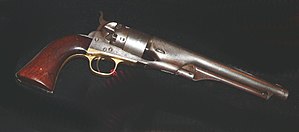Colt 1860 Army
| Colt Army Model 1860 | |
|---|---|

Colt Army Model 1860
|
|
| Type | Revolver |
| Place of origin | United States |
| Service history | |
| Used by | United States (Union) Confederate States Native Americans |
| Wars |
American Civil War American Indian Wars |
| Production history | |
| Designer | Samuel Colt |
| Manufacturer | Colt's Manufacturing Company |
| Produced | 1860 to 1873 |
| No. built | 200,000+ |
| Specifications | |
| Weight | 2 lb, 11 oz (1.22 kg) |
| Length | 14 in (355.6 mm) |
| Barrel length | 8 in (203.2 mm) |
| Height | 5.25 in (133.35 mm) |
|
|
|
| Cartridge | Paper-wrapped .44 caliber round and conical ball (paper cartridge), .44 Colt (conversions) |
| Caliber | .44 |
| Action | Percussion |
| Muzzle velocity | 550–1000 ft/s (167.6–304.8 m/s) |
| Effective firing range | 50–75 yds (45.7–68.6 m) |
| Feed system | 6 round cylinder |
The Colt Army Model 1860 is a muzzle-loaded cap & ball .44-caliber single-action revolver used during the American Civil War made by Colt's Manufacturing Company. It was used as a side arm by cavalry, infantry, artillery troops, and naval forces.
The Colt 1860 Army uses the same size frame as the .36 caliber 1851 Navy revolver. The frame is relieved to allow the use of a rebated cylinder that enables the Army to be chambered in .44 caliber. The barrel on the 1860 Army has a forcing cone that is visibly shorter than that of the 1851 Navy, allowing the Army revolver to have a longer cylinder. Another distinguishing feature of the Colt 1860 Army, first introduced on the Colt 1855 Sidehammer Revolver, is the "creeping" loading lever.
More than 200,000 were manufactured from 1860 through 1873. Colt's biggest customer was the US Government with no less than 129,730 units being purchased and issued to the troops. The weapon was a single-action, six-shot weapon accurate up to 75 to 100 yards, where the fixed sights were typically set when manufactured. The rear sight was a notch in the hammer, only usable when the revolver was fully cocked.
The Colt .44-caliber “Army" Model was the most widely used revolver of the Civil War. It had a six-shot, rotating cylinder, and fired a 0.454-inch-diameter (11.5 mm) round spherical lead ball, or a conical-tipped bullet, typically propelled by a 30-grain charge of black powder, which was ignited by a small copper percussion cap that contained a volatile charge of fulminate of mercury (a substance that explodes upon being subjected to a sharp impact). The percussion cap, when struck by the hammer, ignited the powder charge. When fired, balls had a muzzle velocity of about 900 feet per second (274 meters/second), although this depended on how much powder it was loaded with.
...
Wikipedia
